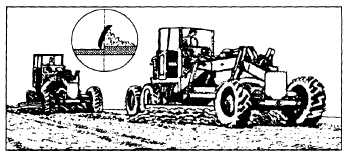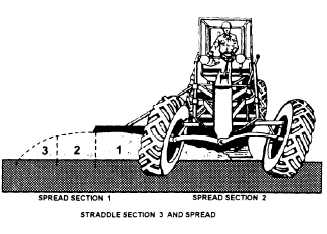the blade should be extended well to the side and angled
to side cast the windrow to the inside of the rear tires.
The pile is reduced by using a series of side cuts, as
shown in figure 10-31. Piles to be spread by a grader
should be spread dumped as much as possible. The load
to be spread is limited by the power and traction of the
grader.
When there is not enough room to use the wide side
reach and the piles of material are not too high, the front
wheels may be driven over the piles. The front axles
push the top off the pile, and the blade cuts as much as
power permits. The blade should be positioned well
below its highest point, so when the grader gets hung up
on the piles and loses traction, the blade can be raised to
restore the weight to the rear wheels. When traction is
lost and the tires spin, unnecessary tire wear increases.
Road Maintenance
The ability of the grader to blade mix materials used
as road surfaces is an important function in road
maintenance.
When blade mixing, pitch the blade
slightly forward and angled at about 30 degrees. This
position gives the widest possible spread with maximum
mixing action. In mixing, move the windrow from side
to side by successive cuts with the blade.
To increase production, use several graders to
operate, one behind another, on the same windrow (fig.
10-32). When the mixture is wet, mixing should
continue until the mixture is dry. After mixing, the
material is again side tasted into a windrow before
spreading. During mixing, more bitumen or cement can
be applied to any lean sections. All particles of the
completed mix should be coated and uniform in color.
Figure 10-31.—Wide side reach.
Figure 10-32.—Blade-mixing operation.
Blade-mixing operations are performed as rapidly
as possible, consistent with the skill of the operator and
the condition of the surface being maintained.
However, when the grader is operated too fast, it will
tend to bounce and give the surface a washboard
appearance that will take additional time and passes to
connect. When washboarding is not corrected, it will
create unnecessary wear and tear on traffic using the
road or work area.
Snow Removal
Graders can be used for snow removal in the same
way as a snowplow. The blade and circle are adjusted
to side cast snow and slush the same as if side casting
road materials. When the cutting edges are not removed
and replaced with a strip of hard rubber bolted to the
moldboard, raise the blade at least 1/2 to 1 inch when
removing snow from uneven pavement or a runway
surface.
NOTE: Failure to make proper blade adjustments
can result in not only damaging the cutting edges,
moldboard, or grader, but also in gouging and tearing up
the road or runway surface.
Finish Grading
Finish grading is a fine cut or fill of a surface to get
the final desired elevation. This phase of a grading
operation is called blue topping. Blue topping takes
time and patience even for experienced operators.
When performing blue topping operations, make
sure the grader cutting edges are not worn, the tires are
the same size with the correct air pressure, and the tires
are pointed in the right direction. Front tire treads
should be pointed toward the rear, and rear tire treads
should be pointed toward the front. Adjust the blade
pitch all the way forward to scrape instead of cut.
10-14




